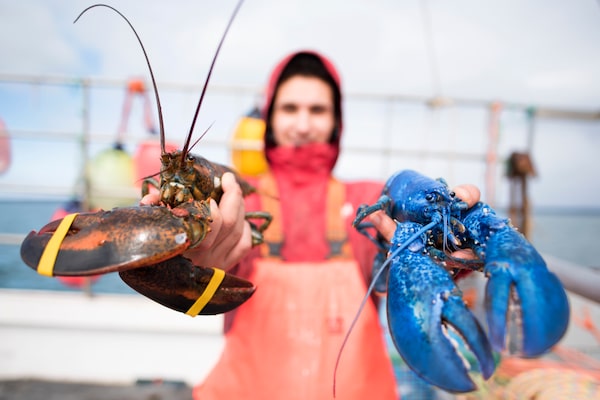
Off the south shore of Nova Scotia, a lobster fisherman hoists the fruits of his labour. Lobster fishing is a lucrative business in the Maritimes, but it's under increasing price pressure for their usual species of bait fish.Lex Brukovskiy
Like whales breaching ocean swells, silver carp fly out from beneath the surface of waterways in Illinois. The rubbery, wriggling fish, some weighing a hulking 20 kilograms, careen through the air and over ducking heads fast enough to break jaws, snap bones or knock a boater overboard.
Tens of millions of dollars have been spent trying to keep the invasive fish – which procreate rapidly, crowding out other marine life – from spilling into the $7-billion Great Lakes fishery.
And in an era of expeditious information-sharing, the “flying fish,” a form of Asian carp imported into the States decades ago, with hopes of using them to manage American ecosystems, have also caught the attention of gawking social-media spectators around the world.
Three years ago, one of those spectators was a Nova Scotian named Patrick J. Swim. But instead of merely gawking, the self-described “lobsterpreneur” hatched a plan: What if he could bring the fish to Canada, frozen in pieces, to sell as lobster bait? It could reduce the silver-carp population back in Illinois, lower their chances of spilling into the Great Lakes – and, more to the point, ease rising bait prices in Atlantic Canada. Even saving 10 cents a pound would make a huge difference, Mr. Swim says, for fishermen buying an average estimated 40,000 pounds (about 18,000 kilograms) of bait every year.
“That’s your vacation, or your Christmas presents,” he says. “Or whatever four grand buys, which is a lot for a fisherman. With fuel, it’s crazy what they spend.”
But would silver carp catch lobster? “That was the million-dollar question.”

A lobster fisherman casts a line off the southern Nova Scotia coast. This year's lobster-trapping season starts there in mid-October.Lex Brukovskiy
This fall, after months of testing – not to mention navigating the bureaucracy of Canadian import restrictions – Mr. Swim is hoping to use the despised fish to beguile the delectable crustacean, and in time for the upcoming lobster-trapping season, which launches Oct. 15. Among other buoyant attributes, he notes, silver carp “slimes up well.”
But he needs permission from several government bodies to bring the dead fish – which is a thorn in the side of conservationists when alive and swimming through waterways – from Illinois to Nova Scotia. Each of those authorities has to be certain the fish pose no posthumous threat to Canadian lakes and rivers. So far, he has received a crucial thumbs up from the Department of Fisheries and Oceans (DFO). He has also worked with Canadian and American fishermen, and has even put together a video of many of them expressing full-throated support for his plan. He has consulted with suppliers, dealers and experts, roped in additional support from local politicians, and, not incidentally, brought in the help of his family members – because for the Swims, lobster has always been the family business.
The Swim family settled in the Maritimes in the early 1800s, making their home on Cape Sable Island – a low, sandy jut of land with a sky-reaching lighthouse, on the southernmost tip of Nova Scotia. Locals call it Cape Island. The family’s roots in the crustacean industry can be traced all the way back to Albert S. Swim, who chose to retire from his life as a sea captain in 1896 and start a lobster and groundfish business on Swims Point – which was named for a man named Michael Swim, generally accepted by local historians as the area’s first permanent resident.
From there, generation after generation snapped up their posts in the lobster industry. Patrick Swim himself, who grew up in the Halifax suburb of Bedford, has spent much of his life tangled in the lobster business: brokering, shipping, fishing, packing, and working on lobster-based endeavours, from lobster-roll restaurants to the designing and marketing of new kinds of bands to keep wayward claws shut. In his earliest years in the business, during the late 1980s, he sold lobster on the side of the road.
But as the decades have ebbed on, the waters have changed. Herring and mackerel catches have been dropping for years, says Geoff Irvine, the executive director of the Lobster Council of Canada. Those two fish make up most of the bait used in the lobster fishery, bolstered by a smattering of crab and other random species such as sculpin, a cod-like fish.
And although Mr. Irvine hasn’t heard anything about bait issues being of particular concern this year – a lot of lobster bait, he notes, can be imported from Asia and Europe – Mr. Swim is among those who think a reckoning is imminent. “It’s definitely tightening,” he says.
Ryan Schoor (aptly pronounced “shore”) works in his own family business, Ace of Baits, based in Ladysmith, B.C., and says the bait-shortage problem goes deeper than dwindling catches. For the last half-dozen or so years in China and other countries, herring has been sold for human consumption at higher prices than it can be as Canadian bait, putting pressure on prices here.
On the West Coast, it has recently gone as high as $1.80 or $2 a pound, he says, compared to somewhere around 60 cents just a few years ago. Throw in higher fuel prices and fisheries implementing new regulations, and it’s become a much more expensive world on the water.
“All that coupled together has created a panic, in most cases, for bait,” says Mr. Schoor.
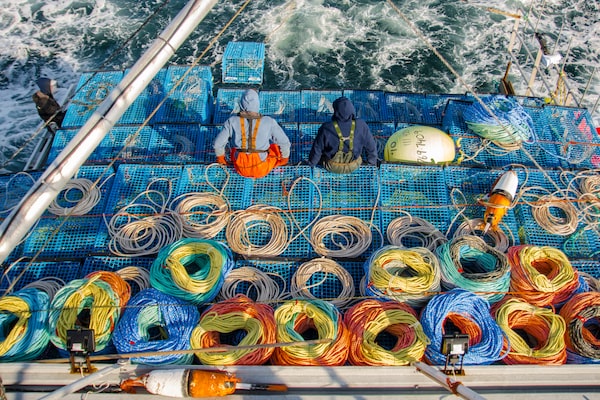
Lobster traps and ropes lie aboard a fishing boat off Nova Scotia's South Shore. The boat is in District 34, one of the areas carved out by the Department of Fisheries and Oceans around the Maritimes and Quebec to set limits on how many traps can be laid and when fishing seasons open and close.Lex Brukovskiy
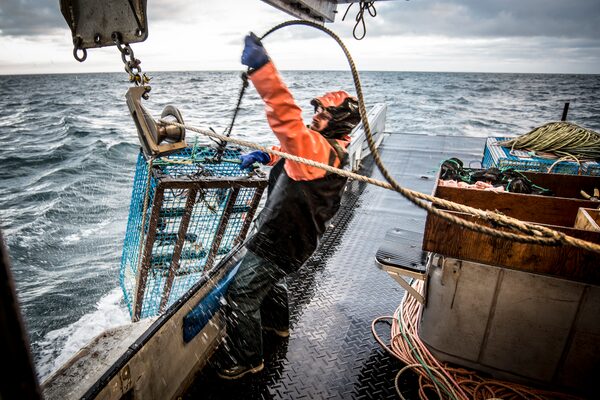
Herring and mackerel make up most of the bait that lobster fishermen use, but catches of the fish have been in decline over the years. China and other countries have been selling herring for human consumption at higher prices than bait, putting pressure on Canadian buyers.Lex Brukovskiy
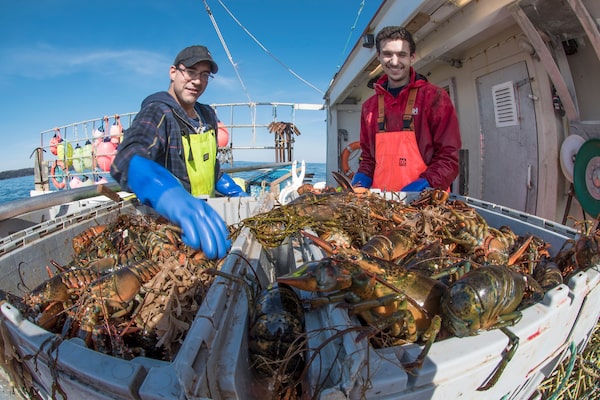
Lobster is one of Canada's highest-value fisheries exports, bringing in more than $2.1-billion in 2017.Lex Brukovskiy

Lobster fishing in the Maritimes
QUEBEC
Gander
NEWFOUNDLAND
Gulf of
St. Lawrence
St. John’s
PEI
N.B.
Sydney
NOVA SCOTIA
Saint John
Bedford
Halifax
Atlantic Ocean
Yarmouth
Swims Point,
Cape Sable
Island
Lobster fishing areas
American lobster
Homarus americanus
About:
Large,hard-shelled
crustacean found in
northwest Atlantic
waters. Can live up
to 50 years
Habitat:Ocean bottom in
rocky areas where it can
hide
Diet:Varied selection of
mollusks, crabs, shrimp
and small fish
Anatomy
Head
Thorax
Abdomen
Crusher
claw
Tail fin
Swimmerets
Walking legs
Pincer claw
Up to: 60cm
SOURCE: usgs; parl.ns.ca; tastelobster.ca;
fisheries and oceans canada

Lobster fishing in the Maritimes
QUEBEC
Gander
Anticosti Isl.
NEWFOUNDLAND
Gulf of
St. Lawrence
St. John’s
N.B.
PEI
Sydney
Moncton
NOVA SCOTIA
Saint John
Bedford
Atlantic Ocean
Halifax
Yarmouth
Swims Point,
Cape Sable
Island
Lobster fishing areas
American lobster
Homarus americanus
About:Large,hard-shelled
crustacean found in
northwest Atlantic
waters. Can live up
to 50 years
Habitat:Ocean bottom in
rocky areas where it can
hide
Diet:Varied selection of
mollusks, crabs, shrimp
and small fish
Anatomy
Head
Thorax
Abdomen
Crusher
claw
Tail fin
Swimmerets
Walking legs
Pincer claw
Up to: 60cm
SOURCE: usgs; parl.ns.ca; tastelobster.ca; fisheries
and oceans canada

Lobster fishing in the Maritimes
QUEBEC
Gander
Anticosti
Island
NEWFOUNDLAND
Gulf of
St. Lawrence
St. John’s
NEW
BRUNSWICK
PEI
Sydney
Moncton
NOVA SCOTIA
Saint John
Bedford
Atlantic Ocean
Halifax
Yarmouth
Swims Point,
Cape Sable
Island
Lobster fishing areas
Head
Thorax
Abdomen
Crusher
claw
American lobster
Homarus americanus
About:Large, hard-shelled
crustacean found in northwest
Atlantic waters. Can live up
to 50 years
Tail fin
Swimmerets
Habitat:Ocean bottom in
rocky areas where it can hide
Walking legs
Diet:Varied selection of
mollusks, crabs, shrimp and
small fish
Pincer claw
Up to: 60cm
SOURCE: usgs; parl.ns.ca; tastelobster.ca; fisheries and oceans canada
Enter the silver carp as a contentious contender for easing the burden of a bait-challenged industry. And enter, as well, its champions, alongside Mr. Swim and his fellow fishermen. In a July 9 letter of support for her constituent addressed to the DFO, local MP Bernadette Jordan expressed her belief that importing the carp could “save mackerel and herring stocks from depletion” – a “great option for Atlantic Canada,” she wrote. The initiative could also help protect the Great Lakes, which, after all, would be good news for both the U.S. and Canada.
Ms. Jordan and Mr. Swim have science on their side: Peter Sorensen is a University of Minnesota professor who has studied the invasive carp and consulted with officials on containment measures, and says the fish don’t appear to carry any disease or toxicity.
When told of Mr. Swim’s idea by the Globe and Mail, Prof. Sorensen said that his mind returned to the last time he consulted on a proposal to use dead carp as lobster bait. Then, it was the common carp – not the silver carp – a separate but similarly invasive species. And, in the end, the “invasive” label that is attached to carp was a sticking point, and the plan didn’t come to fruition. Many people don’t think of common carp as invasive, he says, though they are. The vexatious silver carp, when alive, are even harder to ignore. “No politician, no fisherman, no one can ignore something that’s jumping like that.”

Silver menace: plan to use invasive
carp as lobster bait
CANADA
Nfld.
U.S.
N.S.
L. Mich.
Detail
Illinois
Ohio
River
Dead silver carp would
be sent to Nova Scotia
from Illinois to be used
as cheaper lobster bait
Miss. River
Gulf of Mexico
Silver carp detected*
American lobster range
Silver carp
Hypophthalmichthys molitrix
About:Introduced from Asia in
1973. Can live up to 20 years
Habitat:Mainly large rivers
Diet:Phytoplankton; zooplankton
Can leap
three metres
in the air
Up to: 1 metre
*Map represents collection records only and may not
reflect actual distribution of established populations
SOURCE: usgs; fisheries and oceans
canada; qgis

Silver menace: plan to use invasive
carp as lobster bait
CANADA
Nfld.
U.S.
N.S.
L. Mich.
Detail
Illinois
Ohio River
Dead silver carp would
be sent to Nova Scotia
from Illinois to be used
as cheaper lobster bait
Miss. River
Gulf of Mexico
Silver carp detected*
American lobster range
Silver carp
Hypophthalmichthys molitrix
About:Introduced from Asia in
1973. Can live up to 20 years
Can leap
three metres
in the air
Habitat:Mainly large rivers
Diet:Phytoplankton; zooplankton
Up to: 1 metre
*Map represents collection records only and may not reflect actual
distribution of established populations
SOURCE: usgs; fisheries and oceans canada; qgis

Silver menace: plan to use invasive carp as lobster bait
Dead silver carp would
be sent to Nova Scotia
from Illinois to be used
as cheaper lobster bait
CANADA
Nfld.
U.S.
Nova Scotia
L. Mich.
Detail
Illinois
Silver carp
Hypophthalmichthys molitrix
Ohio River
About:Introduced from Asia in
1973. Can live up to 20 years
Mississippi River
Habitat:Mainly large rivers
Diet:Phytoplankton; zooplankton
Gulf of Mexico
Can leap three
metres in the air
Silver carp detected*
American lobster range
*Map represents collection records only and may not reflect
actual distribution of established populations
Up to: 1 metre
SOURCE: usgs; fisheries and oceans canada; qgis
The U.S. Army Corp of Engineers, U.S. Fish and Wildlife Service, U.S. Coast Guard, U.S. Environmental Protection Agency, as well as the Illinois Environmental Protection Agency and the Illinois Department of Natural Resources have collectively spent tens of millions of dollars to contain the Asian carp, funding everything from locks and dams to a multimillion-dollar electrical-barrier system to block the fish from entering Lake Michigan.
Another response, though, has been to “fish them down” for use in the likes of hot dogs and as menu items in university cafeterias. Which prompts Prof. Sorensen to ask a simple question: “Why not lobster bait? I personally think that sounds like a good use.”
But while any cross-border endeavour comes with red tape, that’s especially true if the product you’re trying to import has been labelled invasive and has proved enormously expensive to keep under control. Starting in May, Mr. Swim says, he went back and forth with the DFO, seeking advice, along the way, from a range of sources and legal experts. Among them was the Toronto Zoo, which has navigated even stricter regulations in order to bring live Asian carp into its exhibits.
Mr. Swim has sought to get written permission to bring the dead fish across the border in time for that first day of the lobster-fishing season, now just a few weeks away. “Dumping day” is just a few weeks after that, on the last Monday in November, when, Mr. Swim says, 1,688 boats in all will head out into the water at six in the morning: “All go out to get to the best grounds to dump their traps, 375 traps per boat.”
And all of them will need bait.
If all the requisite government approvals come through, he would then work with fishermen in Illinois to catch the silver carp in vast nets, and bring their catches to a facility nearby where they’d be gutted on tables and put in barrels – each one holding about 200 pounds of carp. The fish would be frozen and sent to Nova Scotia by truck, each truck carrying roughly 600 barrels. Maritime fishermen could then take the barrels aboard their boats and return them to Mr. Swim’s cousin, Tim Swim, who runs the specialty fish-meal brokerage company Swimco. The recyclable barrels would be washed out there before being sent back to Illinois.
“That’s the hope,” Patrick Swim says.

how plan to sell carp would work
1
2
Silver carp are
caught in big
nets in Illinois
Fish are shipped to
facility where they
are cleaned
4
3
Cleaned fish are
frozen and then
placed in barrels
Barrels trucked
to fishermen in
Nova Scotia
x 600/truck
90KG
Recyclable barrels
washed, sent back
john sopinski/the globe and mail

how plan to sell carp would work
2
1
Silver carp are
caught in big
nets in Illinois
Fish are shipped to
facility where they
are cleaned
4
3
Cleaned fish are
frozen and then
placed in barrels
Barrels trucked
to fishermen in
Nova Scotia
x 600/truck
90KG
Recyclable barrels
washed, sent back
john sopinski/the globe and mail

how plan to sell carp would work
4
2
3
1
Silver carp are
caught in big
nets in Illinois
Fish are shipped to
facility where they
are cleaned
Cleaned fish are
frozen and then
placed in barrels
Barrels trucked
to fishermen in
Nova Scotia
x 600/truck
90KG
Recyclable barrels
washed, sent back
john sopinski/the globe and mail
At the time of his initial interview with the Globe and Mail in mid-August, Mr. Swim was waiting for written permission from the DFO to bring the fish north. Days later, it arrived. A short note from the department confirmed that its Maritimes Region Conservation and Protection Policy and Regulatory Development Unit conducted a review of their regulatory requirements around Asian carp, and more specifically silver carp, and its potential use as bait in the lobster fishery.
“As a result of that review there is no prohibition to use that species at this time for lobster bait as long as the fish is dead and eviscerated before it enters Canada as required under the Aquatic Invasive Species Regulations,” it read. The phrase “dead and eviscerated” was simultaneously underlined, bolded and italicized. A follow-up note from the department, shared with The Globe by Mr. Swim, noted that a “slit up the belly of the fish” wasn’t sufficient evisceration – the entrails and internal organs, including the brain and the gills, have to be removed.
“They’re worried about the eggs getting into the rivers,” says Mr. Swim, who plans to comply with the directive. “It’s frozen, it’s dead for two weeks, and it’s in the bottom of the Atlantic, 40 fathom down off Georges Bank.” It wasn’t possible, he says, to imagine the carp somehow showing up alive in the Tusket River.
But Mr. Swim is not entirely out of choppy waters. The DFO can still restrict his use of the carp should any new concern arise about a risk to local water systems of introducing disease, parasites, the carp themselves or other species. Other bodies, from Canada Border Services Agency to each province that the fish may be transported through, can have their own requirements to comply with as well, which Mr. Swim is working hard to iron out.
The Canadian Food Inspection Agency (CFIA), which can prohibit the import of dead silver carp under its Health of Animals Regulations, hadn’t issued any permits as of mid-September to import dead silver carp for bait; Mr. Swim says that Swimco often works with the CFIA, and they’re in the process of working those last hurdles out.
Prof. Sorenson notes that the export of an invasive species can also be tricky for less obvious reasons: If the silver carp become economically viable as an export, creating jobs stateside, American fishermen would likely ask the government to promote and sustain the silver-carp fishery long-term. “Once you start to do that, then you accept it into your economic structure, and there become reasons to not, frankly, exterminate it.” Which could raise red flags among those who see the fish as an enemy.
Officials in Illinois are not unaware of that possibility, according to Kevin S. Irons, program manager of the Aquaculture and Aquatic Nuisance Species Program at the Illinois Department of Natural Resources. But he thinks that fishing the leaping creatures out of local water bodies is their best bet at winnowing populations. “If we don’t start harvesting,” he acknowledges, “there’s very little else we can do.”
The state of Illinois wasn’t about to start restocking the fish or creating any long-term management programs, Mr. Irons says. As the fish start to be used productively, as Mr. Swim is intending to do, Mr. Irons expects the desire for the fish will increase and the carp will be fished down even faster. As a result, business plans that use the carp, for now, are an attractive idea for officials. “It seems like the most prudent thing is to do this,” he says.
Illinois currently estimates that hundreds of millions of pounds of Asian carp can be harvested annually from its waterways, including up to 50 million pounds out of the Illinois River alone, which drains a large part of the state. So he has talked about fishing out the carp for a long time now, with folks just like Mr. Swim.
“We know there’s a need for bait on the East Coast, specifically the stuff Patrick’s talking about,” says Mr. Irons¸ who notes that there’s a company from Missouri taking them down to Louisiana for crawfish bait. “They’re also using it on the Gulf Coast for chum,” he says. The question then became how to get their massive amounts of available fish into the hands of more far-flung fishermen.
“I think people like Patrick are the ones putting it together,” he says.
While the fate of the project is yet unclear, Mr. Swim has been optimistic all the way that if they get all the final go-aheads they need, the folks in the lobster industry can “do some good on both ends” – and put dinner on the table for both lobster fishers and lobster fans.
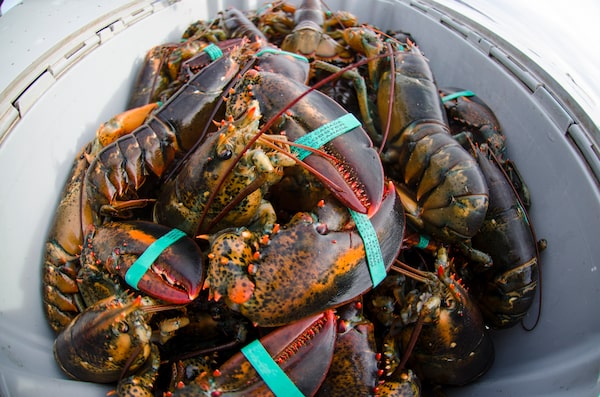
Lex Brukovskiy